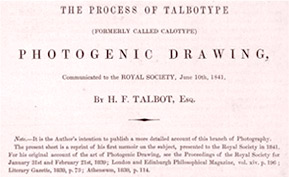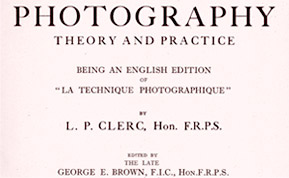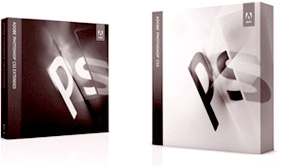 |
|
 |
|
|
What's in a name? In the
case of the Chicago Albumen Works, over 40 years
of history and accumulated experience, and a
roster of successfully completed projects.
Here is a (not so) brief history: |
 |
 |
1976. The Chicago
Albumen Works is founded in Chicago with
the express intent of producing and
selling modern, authentic albumen prints
made by printing original glass plate
negatives obtained from archives and
historical societies. Our first
publication was Eadweard Muybridge,
Yosemite Photographs, 1872,
produced in conjunction with the
Yosemite Natural History Association.
California. It contained 10 mammoth
plate albumen prints of Muybridge's 1872
expedition.
|
|
|
The Muybridge portfolio was
followed soon thereafter by the publication of
21 individual mammoth plate albumen prints
printed directly from the original William Henry
Jackson negatives in the Colorado Historical
Society.
In 1978, CAW was asked to
print a sales edition of 12 Eugène Atget
negatives for sale through the Department of
Photographs at the Museum of Modern Art, New
York City.
Other vintage media printing
projects included individual prints by Francis
Frith (albumen), Éduard Baldus (salted paper);
approximately 100 exhibition prints for the
Museum of Modern Art, New York City, exhibition
series The Work of Atget (albumen);
exhibition prints of the Meserve/Kunhardt Civil
War cdv glass plates at the National Portrait
Gallery, Washington, D.C. (albumen); a
portfolio, Fred E. Miller: Photographer of
the Crows (gelatin POP); prints for the
limited edition publication of American
Frontiers: The Photographs of Timothy H.
O'Sullivan, 1876-1874 (albumen); and a
master set from the Jacob Riis glass plates at
the Museum of the City of New York.
For some of these projects,
we were allowed only limited access to the
original glass plates. This fostered intense
investigation into the making of accurate
duplicate negatives: negatives that would print
on a given medium as if they were the original
glass or film.
|
 |
 |
As a result of
this work, in 1980 the Library of
Congress contracted CAW to begin
duplicating as-yet-undeteriorated
cellulose acetate negatives by Frances
Benjamin Johnston. For the next two
decades, CAW was considered preeminent
in the field of archival negative
duplication, duplicating collections of
glass plate, nitrate, and acetate
negatives so the originals could be
removed from everyday service and stored
in proper archival conditions, which for
film negatives means cold storage at 0°
F.
|
|
|
A sample of our major
duplicating projects includes:
|
 |
The
Civil War and Western Exploration
collodion negative collections at the
National Archives and |
 |
 |
Records
Administration, Washington, D.C.
|
 |
 |
The
Civil War cartes de visite
collection at the National Portrait
Gallery, Washington,D.C. |
 |
 |
The
William Henry Jackson mammoth dry plate
collection at the Library of Congress,
Washington, D.C. |
 |
 |
The
glass plate negatives of H. H. Bennett
at the Wisconsin Historical Society,
Madison, Wisconsin |
 |
 |
The
Jack London Negative Collection at Jack
London State Historical Park, Glen
Ellen, California |
 |
 |
Negatives
from the Lyndon Baines Johnson
Presidential Library, Austin, Texas
|
 |
 |
Negatives
from the Metropolitan Opera Association,
New York City |
 |
 |
Negatives
from the National Archives and Records
Administration, Pacific Alaska Region,
Anchorage, |
 |
 |
Alaska;
Pacific Region, Laguna Niguel,
California; Pacific Region, San
Francisco, California; |
 |
 |
and
Southeast Region, East Point, Georgia
|
 |
 |
Negatives
from the National Park Service,
Everglades National Park, Homestead,
Florida; Glacier |
 |
 |
National
Park, Montana; and San Juan Historic
Site, Puerto Rico |
 |
 |
The
Walker Evans Archive, Metropolitan
Museum of Art, New York City |
 |
 |
Glass
plate and film negatives from
collections at the Mariners' Museum,
Newport News, Virginia |
 |
 |
Glass
plate negatives from The New Jersey
Historical Society, Newark, New Jersey
|
|
|
By the early 1980s, the
question of what to do with already deteriorated
cellulose acetate negatives remained unanswered,
and CAW was in a unique position to offer a
solution. The problems associated with the
recovery of emulsion layers from deteriorated
acetate negatives did not have to do with
removing the emulsion itself, rather, it was
what to do next. The procedures tested up to
then produced a free-floating emulsion layer
that was grossly fragile and unstable. If it
could be unfolded and aligned, it could only be
re-adhered to glass.
Addressing these two
drawbacks, CAW melded the acetate stripping
procedures into its already accurate and highly
calibrated negative duplicating facility. By
rigorously controlling the amount of water in
the stripping routine, CAW eliminated the
problems of fragility and dimensional stability.
Furthermore, the new procedure allowed the
recovered image pellicle to dry directly in an
archival paper sling without adhering to it, and
the duplicating procedure produced a
preservation interpositive and an accurate
working negative.
Below are a few of the
larger projects involving the recovery of
severely deteriorated acetate negatives:
|
 |
 |
Deteriorated
negatives in the Walker Evans Archive,
Metropolitan Museum of Art, New York
City |
 |
 |
Deteriorated
medical X-rays of Avatar Meher Baba from
the Sheriar Foundation, North Myrtle
|
 |
 |
Beach,
South Carolina |
 |
 |
Deteriorated
negatives in the Lucas/Monroe Theater
Collection and the Gottscho-Schleisner
|
 |
 |
Collection,
Museum of the City of New York |
 |
 |
Deteriorated
negatives in the Carnegie Survey of the
South, Library of Congress, Washington,
D.C. |
 |
 |
Deteriorated
negatives in the Norfolk and Western
Historical Photograph Collection,
Norfolk |
 |
 |
Southern
Corporation, Norfolk, Virginia |
 |
 |
Deteriorated
microfilms from the US Army Heritage and
Education Center, Carlisle, Pennsylvania
|
 |
 |
Deteriorated
X-rays from the US Joint POW/MIA
Accounting Command, Hickam AFB, Hawaii
|
 |
 |
Deteriorated
negatives in the Bill Brandt Archive,
London, UK. |
 |
 |
Deteriorated
negatives in the Type Photograph
Collection [of botanical specimens] at
the Field |
 |
 |
Museum
of Natural History, Chicago, Illinois
|
|
|
By the year 2000, the
digital tsunami had hit. Institutions were
dismantling their wet labs and replacing them
with digital studios and print labs. The
negative preservation doctrine of "duplicate and
freeze" was giving way to "digitize and freeze."
|
 |
 |
In response to
these movements, CAW embraced digital
technology, acquiring top-of-the line
digital cameras, scanners, printers and
film recorders, and hiring staff whose
experience blended digital expertise
with traditional photographic
sensibilities.
Today, CAW produces archive quality
digital files of all types of
2-dimensional media.
|
|
|
Through our film
recorders, we make archive quality duplicate and
copy negatives.
Through our digital printers, we make museum
quality fine art reproductions.
In our wet labs, we produce silver halide POP
(salt, albumen, and gelatin) and DOP prints for
exhibition.
In our acetate stripping labs, we recover and
digitize deteriorated films of all sizes.
Some of the digital projects we have done over
the past decade: |
 |
 |
Digitized
11,000 glass plate and film negatives
from the Wurts Brothers Collection,
Museum |
 |
 |
of
the City of New York. |
 |
 |
Digitized
and made LVT duplicate negative outputs
of 500 negatives in the Lucas-Monroe
|
 |
 |
Theatre
Collection, Museum of the City of New
York |
 |
 |
Made
LVT copy negative outputs of 4,200
digital files from the Carl Sandburg
Collection, |
 |
 |
University
of Illinois, Urbana, Illinois |
 |
 |
Digitized
18,000 original negatives and 8,000
prints from the Norman Rockwell Studio
Collection, Norman |
 |
 |
Rockwell
Museum, Stockbridge, Massachusetts
|
 |
 |
Digitized
and made LVT copy negatives and
traditional silver prints of 8,500
prints in the 1934 |
 |
 |
Aerial
Survey Collection, Connecticut State
Library, Hartford, Connecticut |
 |
 |
Digitized
5,000 nitrate negatives from the Sidney
D. Gamble Collection, Duke University,
|
 |
 |
Durham,
North Carolina |
 |
 |
Printed
the entire exhibition Norman
Rockwell: Behind the Camera,
Norman Rockwell Museum, |
 |
 |
Stockbridge,
Massachusetts and the Brooklyn Museum,
Brooklyn, New York |
 |
 |
Digitized,
conserved, and constructed surrogate
copies of a 7' by 9' assemblage of
panoramic |
 |
 |
glass
plate transparency views of Deadwood,
for the City of Deadwood, South Dakota
|
 |
 |
Digitized
on-site 12,000 glass plate negatives
from the Department of Bridges
Collection, |
 |
 |
Municipal Archives, New York City
Department of Records and Information
Services, New York City |
 |
 |
Digitized
2,428 rolls of 35 mm film (55,000
frames) from the Deerfield Academy
Photograph Archive |
|
|
The Chicago Albumen Works
remains committed to the values it brought to
photograph preservation in the 1980s and 1990s.
While working in a digital environment expands
the services we can offer, it does not diminish
the attention we pay to the photographic and
fine art objects we work with, nor to the needs
of the institutions and individuals that are our
clients. Every phase of our history has had a
role in informing how we approach the next
challenge --and every challenge is an
opportunity to bring our experience forward.
|
 |
 |
 |
 |
|
 |

